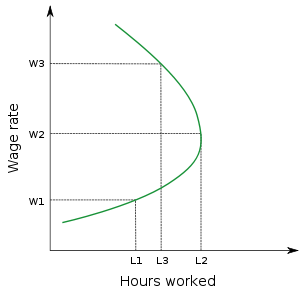Labour supply
In mainstream economic theories, the labour supply is the total hours (adjusted for intensity of effort) that workers wish to work at a given real wage rate. It is frequently represented graphically by a labour supply curve, which shows hypothetical wage rates plotted vertically and the amount of labour that an individual or group of individuals is willing to supply at that wage rate plotted horizontally.
Neoclassical view

Labour supply curves derive from the 'labour-leisure' trade-off. More hours worked earn higher incomes, but necessitate a cut in the amount of leisure that workers enjoy. Consequently, there are two effects on the amount of labour supplied due to a change in the real wage rate. As, for example, the real wage rate rises, the opportunity cost of leisure increases. This tends to make workers supply more labour (the "substitution effect"). However, also as the real wage rate rises, workers earn a higher income for a given number of hours. If leisure is a normal good—the demand for it increases as income increases—this increase in income tends to make workers supply less labour so they can "spend" the higher income on leisure (the "income effect"). If the substitution effect is stronger than the income effect then the labour supply slopes upward. If, beyond a certain wage rate, the income effect is stronger than the substitution effect, then the labour supply curve bends backward. Individual labor supply curves can be aggregated to derive the total labour supply of an economy.[1]
Marxist view
From a Marxist perspective, a labour supply is a core requirement in a capitalist society. To avoid labour shortage and ensure a labour supply, a large portion of the population must not possess sources of self-provisioning, which would let them be independent—and they must instead, to survive, be compelled to sell their labour for a subsistence wage.[2][3] In the pre-industrial economies wage labour was generally undertaken only by those with little or no land of their own.[4]
See also
Scientific journals dealing with labour supply
- Journal of Labor Economics
- Review of Economics of the Household
- Journal of Human Resources
- Journal of Public Economics
References
- Ehrenberg and Smith, "Modern Labor Economics", HarperCollins, 2008
- Maurice Dobb (1947) Studies in the Development of Capitalism New York: International Publishers Co. Inc.
- David Harvey (1989) The Condition of Postmodernity
- Peter J. Bowden (1967) chapter Agricultural prices, farm profits, and rents, section "A. The long-term movement of agricultural prices" - "The long-term trend of prices". Published in The agrarian history of England and Wales, vol 4: 1500-1640, edited by Joan Thirsk. Also published in Chapters from the Agrarian History of England and Wales, 1500-1750, p. 18: "Wage-earning is not a pursuit that is normally engaged for its own sake, and in a peasant economy it is followed only by men with little or no land of their own."
Further reading
- Arrighi, G. (1970). "Labour supplies in historical perspective: A study of the proletarianization of the African peasantry in Rhodesia". The Journal of Development Studies. 6 (3): 197–234. doi:10.1080/00220387008421322.
- Richard Blundell and Thomas MaCurdy, 2008. "Labour supply," The New Palgrave Dictionary of Economics, 2nd Edition Abstract.
- Ellen Meiksins Wood (2002) The Origins of Capitalism: A Longer View London: Verso